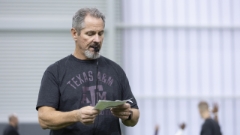
Moffitt's method intent on turning A&M's elite DNA into maximum CBAs
Texas A&M football players have elite DNA. The Aggies just need to elevate their level of CBA (Certified Bad Asses).
That's the task of Tommy Moffitt, A&M’s celebrated new Director of Football Strength & Conditioning. He’s here to toughen up a team that’s sometimes accused of being soft.
The DNA and CBA references will be explained later. But Aggies can be encouraged by the fact Moffitt knows how to transform prospects into predators.
Awarded National Strength & Conditioning Coach of the Year five times, Moffitt supervised S&C programs for three LSU national championship football teams. All were won under different head coaches.
You probably already knew that. What you may not know — or might have forgotten — is that many of A&M’s most successful teams were trained by highly-regarded S&C coaches.
Mike Clark, now with the NFL’s Detroit Lions, trained R.C. Slocum’s championship teams of the ‘90s.
Larry Jackson, now with the NFL’s Cleveland Browns, trained A&M teams that posted 20 victories in the first two seasons in the Southeastern Conference.
Jerry Schmidt trained the A&M team that finished No. 4 in the 2020 final polls.
But Schmidt left for Oklahoma in 2021, and A&M’s toughness seemed to have left him.
That same year, LSU hired coach Brian Kelly, who replaced Moffitt with Jake Flint, Kelly’s long-time S&C coach at Notre Dame.
Moffitt spent the next two years concentrating on “The Moffitt Method,” his private Strength & Conditioning services business.
Meanwhile, A&M managed just 12 victories over the next two seasons combined. That, of course, led to hiring coach Mike Elko away from Duke.
Learning Elko needed a S&C coach, Moffitt enthusiastically pursued the job. That’s like Bobby Flay asking to cook you dinner.
In a short time, Moffitt has the Aggies working out much harder than they have the previous two off-seasons.
“The total load — the amount of work that we do in one day — is probably equal to about three or four days of what they were doing before,” Moffitt said. “We’re probably at 50 to 60 percent of our normal load that we’re accustomed to prescribing. I would say we’re working at about a 40 or 50 percent efficiency rate right now, so we have a ways to go.”
If you think that’s a new coach exaggerating his influence, consider junior defensive end Shemar Stewart’s description of Moffitt’s workout plan.
“Tough, really, really tough,” Stewart told Texas Aggies United earlier this week. “A lot more running for sure. A lot more running. There’s more of a power-lifting base. Certain weeks, (Moffitt) focuses on different parts of our body. Two hours a day workouts …”
From those workouts, Moffitt has come to two definite conclusions. First, the Aggies are really fast.
“The good thing about it is speed is something that is really based on DNA,” Moffitt said. “You can enhance it to some degree, but speed is highly dependent on what your DNA is.”
The effects of that DNA have been on full display in workouts.
“We sprinted on Tuesday, and the average max velocity in miles per hour was 20.1,” Moffitt said. “Our defensive backs and wide receivers — the entire group out of those guys — averaged 20.1 miles per hour. We measured their max velo in 20 yards. The average guy had 20.1 miles per hour, which is flying.
“The linebackers, for that position, elite speed would be 19-and-a-half and above. We probably had 15 guys to hit that. The same with the linemen. We have a very fast team, which is good.”
The second conclusion?
The Aggies aren’t strong enough to consistently win physical SEC confrontations.

“We have to get stronger,” Moffitt said. “Every position on our team, from the wide receivers to the offensive line to secondary to defensive line, we have to get that strength.
“Strength is a little more generalized (than speed). Our team has very good DNA, but we need to spend some time in the weight room and continue to get stronger so that we’re better at the point of impact. That’s as simple as I can put it.”
To be more specific, Moffitt said defensive backs must get stronger to effectively jam receivers at the line of scrimmage. Receivers need more strength to fight through jams, get downfield and block.
“We’ve got to get stronger at the point of attack,” Moffitt said. “There’s this very explosive isometric contraction that all offensive and defensive linemen experience at the point of impact. We’ve got to get better there.
“So, that’s going to be the greatest area that we have to make up. The most difficult area to make up in my industry is speed because it’s highly dependent on DNA.
“We have good speed. We’ve just got to continue to get stronger so we’re better at the point of impact.”
Don’t worry, though. Moffitt is confident he can build the Aggies’ (CBA) to acceptable levels by the time they open the season against Notre Dame on Aug. 31.
"It’s going to take a great deal of work,” he said. “A big commitment. Consistency. Discipline. Every day, every set, every exercise, every rep.
“I tell them every day that every second counts. We can’t waste a minute of any day. We’ve got our work cut out for us, but I’m excited about it.”




